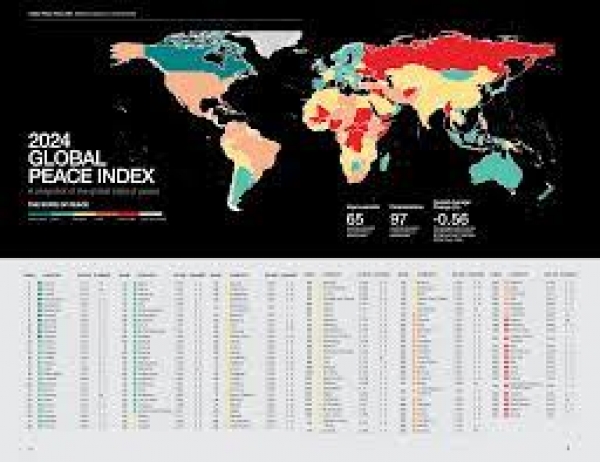This article provides a brief overview of the Global Peace Index (GPI), annually published by the Institute for Economics and Peace (IEP). The IEP works to develop new conceptual frameworks and metrics to define and measure peace, promoting a better understanding of the cultural, economic and political factors that create peace.
The GPI is the world’s leading measure of global peacefulness, offering the most comprehensive data-driven analysis to-date on trends in peace, its economic value, and how to develop peaceful societies. The Index uses 23 qualitative and quantitative indicators from highly respected sources and measures the state of peace in 163 independent states and territories (99.7% of the world’s population) across three domains: the level of Societal Safety and Security; the extent of Ongoing Domestic and International Conflict; and the degree of Militarisation.
The 2024 Report finds that there are currently 56 active conflicts in the world, the highest number on record since the end of the Second World War. Primarily driven by the conflicts in Gaza and in Ukraine – singled out as examples of “forever wars” where prolonged violence becomes seemingly endless without clear resolutions – the average level of global peacefulness deteriorated by 0.56 per cent. This is the 12th deterioration in the last 16 years. Out of 163 countries analysed, 97 recorded a deterioration in peacefulness, while 65 improved their situation. The conflicts, the Report points out, are increasingly internationalised, with 92 countries now engaged in a war beyond their borders. This is the highest number ever recorded since the Index was introduced in 2008. The growing number of ongoing conflicts, coupled with increasing internationalisation and worsening militarisation, indicates that the likelihood of another major conflict is higher than at any time since the inception of the GPI.
Iceland remains the most peaceful country in the world, a position it has held since 2008. It is joined at the top of the Index by Ireland, Austria, New Zealand, and Singapore. Italy ranks 33rd, ahead of countries such as the United Kingdom, Sweden and Greece. Yemen is the least peaceful country in the world, followed by Sudan, South Sudan, Afghanistan and Ukraine. This is the first year that Yemen has been ranked as the least peaceful country in the world, with the country having fallen 24 places in the rankings since the inception of the Index. “Peace inequality” continues to grow. The gap between the most and least peaceful countries in the world is now wider than it has been at any point in the last 16 years. Europe is the most peaceful region in the world and is home to eight of the ten most peaceful countries. The Middle East and North Africa region remains the world’s least peaceful region.
The GPI also aims to assess the economic value of peace. The global economic impact of violence was $19.1 trillion in 2023, equivalent to 13.5 per cent of global GDP, or $2,380 per person. This results in an increase of 0.83 per cent – or $158 billion – from the previous year, largely driven by a 20 per cent increase in GDP losses from conflict. In contrast, expenditure on peacebuilding and peacekeeping was $49.6 billion in 2023, less than 0.6 per cent of total military spending in PPP terms. The largest increases in the economic impact of violence occurred in Palestine and Israel, where the total impact increased by 63 per cent and 40 per cent respectively. Ukraine, Afghanistan, and North Korea incurred the highest relative economic cost of violence in 2023, equivalent to 68.6, 53.2, and 41.6 per cent of GDP, respectively.
This year’s Report also includes an assessment of war in the 21st century, which is changing as a result of two key trends: changes in military technology and increasing geopolitical competition. While asymmetric warfare is not a new phenomenon, the growing proliferation of technologies like drones makes it much easier for non-state groups, as well as smaller or less powerful states, to compete in conflicts with larger states or governments. Between 2018 and 2023 the number of states using drones rose from 16 to 40, a 150 per cent increase. Over the same period, the number of non-state groups who committed at least one drone attack rose from six to 91, an increase of over 1,400 per cent.
Geopolitical shifts are singled out as further complicating global conflict management. Firstly, over the last decade, there has been an increasing diffusion of power, with the world becoming increasingly multipolar. Traditional powers are stretched thin, limiting their ability to manage global tensions effectively. Secondly, the steep increase in the total number of conflicts has led to the problem of distraction. The focus on conflicts in Gaza and in Ukraine has meant many other conflicts go relatively unnoticed, thus receiving much less aid than is required, including in Myanmar, the Democratic Republic of Congo, and Nagorno-Karabakh. Thirdly, there has been an emphasis on military solutions, rather than addressing the underlying grievances that have fuelled the conflict. Overall, the Index highlights that the number of conflicts that end through a peace agreement has fallen significantly, from just under 23 per cent in the 1970s to just over four per cent in the 2010s.
The Report concludes that the key to building peacefulness in times of conflict and uncertainty is “Positive Peace”, defined as the attitudes, institutions and structures that create and sustain peaceful societies. IEP has developed a specific approach (the Halo Approach) for capturing problems systemically and contributing to effective policies to build peace. The approach includes a set of 28 building blocks capable of analysing societal systems, designing tailored resilience building programs.
To read more:




